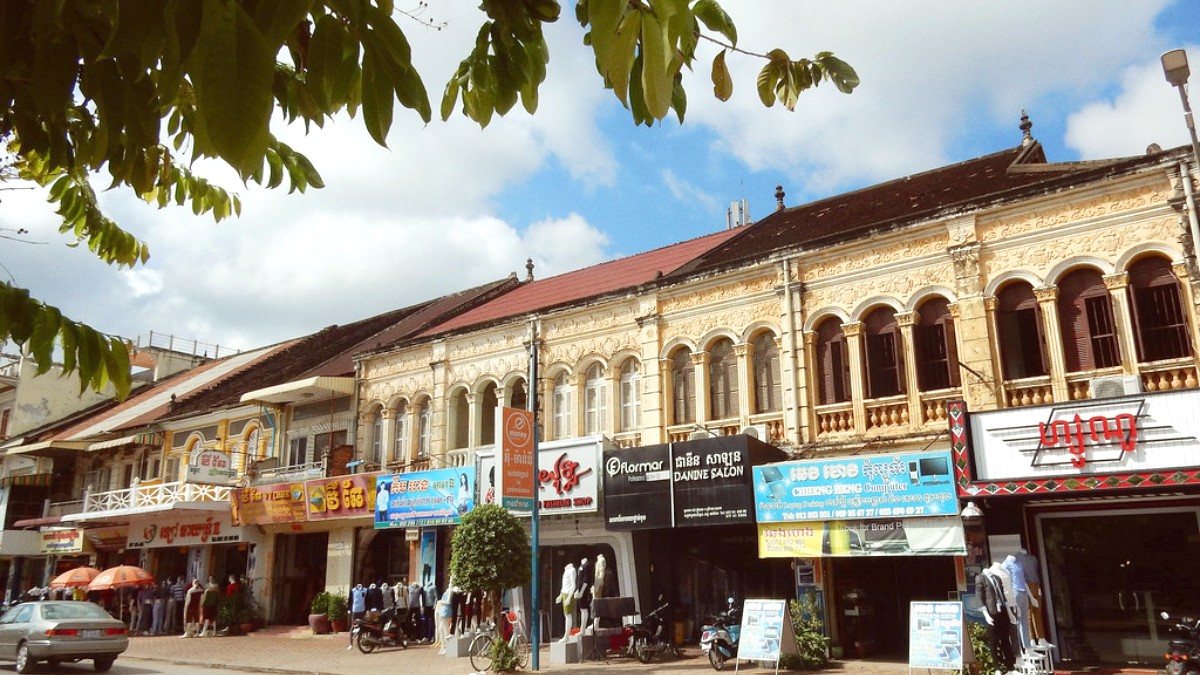
Northwestern Cambodia, Cambodia
Old French colonial architecture lines tree-shaded streets, telling tales of a past era. These buildings now house cafes, guesthouses, and local businesses, creating a living museum. Walk along the Sangkae River, and families picnic, children play, and boats glide by. It feels lived-in, real, and welcoming, painting a picture into the heart of Cambodia.
Battambang also is a hub for arts and creativity. The city fosters a growing contemporary art scene, with galleries displaying local talent.
Phare Ponleu Selpak, a non-profit arts school, is a strong example of this artistic spirit. Its circus performances combine traditional Cambodian storytelling with modern acrobatics, offering an evening of entertainment that also supports a social cause.
Battambang is in northwestern Cambodia, about 290 kilometers northwest of Phnom Penh. It rests on the banks of the Sangkae River, a waterway that serves both as a scenic element and a channel for local life. The city's location within Cambodia's vast plains means it enjoys a relatively flat landscape, ideal for cycling and gentle exploration.
Surrounding Battambang lie fertile agricultural lands, dominated by extensive rice paddies. These fields stretch far, creating a landscape that changes with the seasons. Palm sugar plantations and various fruit orchards also dot the landscape, demonstrating the region's agricultural variety.
A prominent limestone mountain with temples, caves, and a prominent bat exodus at dusk.
An ancient temple on a hilltop south of the city, offering elevated viewpoints.
Flows through the city, providing cool breezes and picturesque views.
Vast green or golden fields that form the scenic backdrop of the rural area.
The Sangkae River links Battambang to this large freshwater lake, permitting seasonal boat travel.
Battambang’s proximity to the Tonlé Sap Lake, Southeast Asia’s largest freshwater lake, holds influence over its environment and transportation options.
Its location in the country's northwest positions it as a practical stop for travelers moving between Thailand and Cambodia, or between Cambodia's major cities.
The flat terrain makes it an ideal destination for activities like cycling, allowing visitors to easily explore both urban areas and the countryside.
These geographical features contribute significantly to Battambang’s unique identity, creating a serene and inviting setting.
Battambang is a rich history, evident in its architecture and the stories of its people. The city’s past extends back centuries, with signs of human settlement and cultural progression even before the Angkorian era.
Its name, Battambang, meaning "Loss of the Staff," comes from a Khmer legend, hinting at its deep roots in Cambodian folklore and tradition.
Remnants like Wat Banan and Wat Ek Phnom connect Battambang to Cambodia’s imperial past, offering intimate experiences of Angkorian heritage.
Established administrative buildings, charming villas, and shophouses define much of the city center today, a visual narrative of a colonial past.
Battambang prospered as an agricultural hub, especially for rice production, positioning it as a breadbasket for the country.
Battambang's history includes the profound trauma of the Khmer Rouge regime (1975-1979). Phnom Sampeau, a mountain just outside the city, became a site of atrocities.
Battambang is a compelling snapshot of Cambodian life, combining visual beauty with unique experiences. It presents a picture of tranquility, yet it is a deep well of cultural richness and resilience.
This city welcomes exploration of its corners, engagement with its people, and witness to its understated charm.
Home to Phare Ponleu Selpak arts school and numerous galleries demonstrating contemporary Cambodian artists.
Explore street food stalls and local eateries for genuine Khmer cuisine and cooking classes.
Cycle through rice paddies and visit villages with traditional crafts like rice paper and palm sugar making.
Battambang features unique attractions that shape a memorable visit.